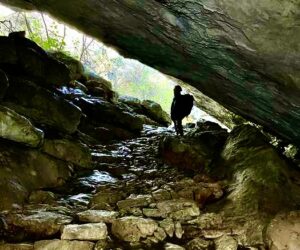
UNIVERSITY OF SOUTH FLORIDA—TAMPA, Fla. (Aug. 27, 2024) – A new study led by the University of South Florida has shed light on the human colonization of the western Mediterranean, revealing that humans settled there much earlier than previously believed. This research, detailed in a recent issue of the journal, Communications Earth & Environment, challenges long-held assumptions and narrows the gap between the settlement timelines of islands throughout the Mediterranean region.
Reconstructing early human colonization on Mediterranean islands is challenging due to limited archaeological evidence. By studying a 25-foot submerged bridge, an interdisciplinary research team – led by USF geology Professor Bogdan Onac – was able to provide compelling evidence of earlier human activity inside Genovesa Cave, located in the Spanish island of Mallorca.
“The presence of this submerged bridge and other artifacts indicates a sophisticated level of activity, implying that early settlers recognized the cave’s water resources and strategically built infrastructure to navigate it,” Onac said.
The cave, located near Mallorca’s coast, has passages now flooded due to rising sea levels, with distinct calcite encrustations forming during periods of high sea level. These formations, along with a light-colored band on the submerged bridge, serve as proxies for precisely tracking historical sea-level changes and dating the bridge’s construction.
Mallorca, despite being the sixth largest island in the Mediterranean, was among the last to be colonized. Previous research suggested human presence as far back as 9,000 years, but inconsistencies and poor preservation of the radiocarbon dated material, such as nearby bones and pottery, led to doubts about these findings. Newer studies have used charcoal, ash and bones found on the island to create a timeline of human settlement about 4,400 years ago. This aligns the timeline of human presence with significant environmental events, such as the extinction of the goat-antelope genus Myotragus balearicus.
By analyzing overgrowths of minerals on the bridge and the elevation of a coloration band on the bridge, Onac and the team discovered the bridge was constructed nearly 6,000 years ago, more than two-thousand years older than the previous estimation – narrowing the timeline gap between eastern and western Mediterranean settlements.
“This research underscores the importance of interdisciplinary collaboration in uncovering historical truths and advancing our understanding of human history,” Onac said.
This study was supported by several National Science Foundation grants and involved extensive fieldwork, including underwater exploration and precise dating techniques. Onac will continue exploring cave systems, some of which have deposits that formed millions of years ago, so he can identify preindustrial sea levels and examine the impact of modern greenhouse warming on sea-level rise.
This research was done in collaboration with Harvard University, the University of New Mexico and the University of Balearic Islands.
###
About the University of South Florida
The University of South Florida, a high-impact research university dedicated to student success and committed to community engagement, generates an annual economic impact of more than $6 billion. With campuses in Tampa, St. Petersburg and Sarasota-Manatee, USF serves approximately 50,000 students who represent nearly 150 different countries. U.S. News & World Report has ranked USF as one of the nation’s top 50 public universities for five consecutive years, and this year USF earned its highest ranking ever among all universities public or private. In 2023, USF became the first public university in Florida in nearly 40 years to be invited to join the Association of American Universities, a prestigious group of the leading universities in the United States and Canada. Through hundreds of millions of dollars in research activity each year and as one of the top universities in the world for securing new patents, USF is a leader in solving global problems and improving lives. USF is a member of the American Athletic Conference. Learn more at www.usf.edu.
_______________________
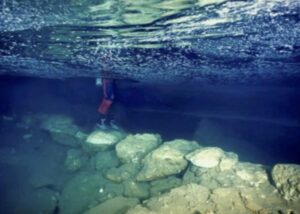
View of the submerged stone bridge from Genovesa Cave, Mallorca, Spain. R. Landreth
_______________________
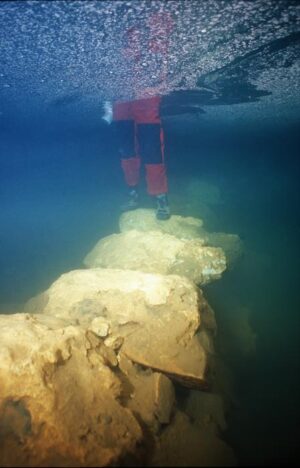
Close-up view of the submerged stone bridge from Genovesa Cave, Mallorca, Spain. R. Landreth
_______________________
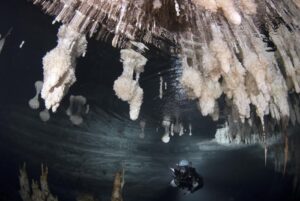
Phreatic overgrowths on speleothems grow exactly at sea level, pictured above the diver in the Galeria de les Delícies in Drac Cave, Mallorca, Spain, offering a more accurate reconstruction of past sea level history. Note the submerged stalagmites that grew when sea level was much lower. M.À. Perelló
_______________________
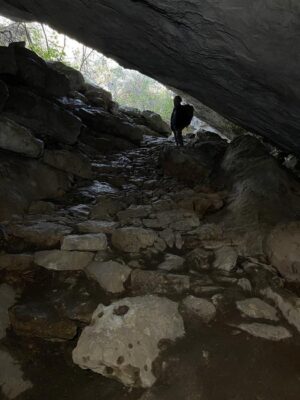
Stone path connecting the entrance in Genovesa Cave, Mallorca, Spain, and its subterranean lake across which the bridge was constructed. B. Onac
_______________________
Article Source: University of South Florida news release.
*Submerged bridge constructed at least 5600 years ago indicates early human arrival in Mallorca, Spain, Communications Earth & Environment, 30-Aug-2024.
_______________________
Advertisement

EXPLORE THE ANCIENT ETRUSCANS IN PERSON!
Experience a unique, up-close-and-personal hike among ancient hilltop towns in central Italy. You will walk the sensational countryside of the regions of Umbria and Tuscany, soaking in important sites attesting to the advanced Etruscan civilization, forerunners of the ancient Romans; imposing architectural and cultural remains of Medieval Italy; local food and drink; and perhaps best of all — spectacular scenic views! Join us in this collaborative event for the trip of a lifetime!




